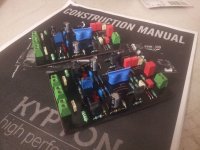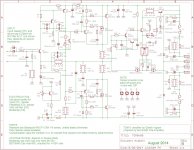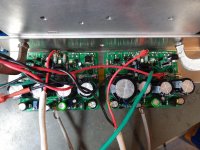While BJT don't have that nice warmth ? ;-)They might be a bit more powerful with their "fancy pants" dual-die LFET's ..... but they won't have that nice BJT "warmness"
C'mon OS ! You HAVE to play with those in real life, stress and listen, and I'm pretty sure that you will not go back to BJTs for your output stages.
They work like a variable resistance, have an infinite current gain at low frequency, are very fast and solid (no secondary breakdown), and don't ask any temperature compensation. And they offer a better "isolation".
They like to work with more quiescent: adjust-it for flat tempco point IE somewhere between 100 and 150ma, witch is nice for an extended class A ...
Just you can blame them for their high parasitic gate capacitance charging the previous stage. But, if you think about, it will really matters at frequencies where the level is lower or null. ~7mA for driving each power device seems usually OK.
Last edited:
You Can make The capacitance work to your avantage, with gatestoppers you can use the capacitance as a mean of compensation.
I my book a lateral OPS is a bit lean an ddry in the bass, BJT's sound more expansive (my purely subjective observation)
I am really sad that thoshiba 220 lat fets are no more, those were really good devices
I my book a lateral OPS is a bit lean an ddry in the bass, BJT's sound more expansive (my purely subjective observation)
I am really sad that thoshiba 220 lat fets are no more, those were really good devices
In a way, yes, and gate stoppers are most of the time a requisite to kill the effects of the gate track or wire inductance.You Can make The capacitance work to your avantage, with gatestoppers you can use the capacitance as a mean of compensation.
But just for local at frequencies upper than the global bandwidth of the amp. Don't trying-it for global compensation, because those gate parasitic capacitances are not linear.
I know..🙂 my current design behaves like a shunt feedback (while not suffering the low impedance drawback) it's 100% unity gain stable, this makes compensation very easy and can be done in numerous ways. One thing I always make sure is that I never feed the circuit RF, input filtering is absolutely mandatory, same is output coil and RC shunt at the output.
Last edited:
My 3 cents into the mosfets, the laterals from renesas are a bit loose at the low end, especially with single pair at the OPS. The IRFP pair is really good and there is audiable diffrence clearly heard when they are driven form differend IPS boards. The best for me are toshibas 150W mosfets but they are not availible anymore.
IMHO IRFP mosfets are really good enough for audio. As a bias spreader I am using irf740 or similar and is working perfect !! Bias is rock solid.
IMHO IRFP mosfets are really good enough for audio. As a bias spreader I am using irf740 or similar and is working perfect !! Bias is rock solid.
Too high RDSon ?My 3 cents into the mosfets, the laterals from renesas are a bit loose at the low end, especially with single pair at the OPS.
Lateral AND bjt combo
Somewhere in this site, someone posted a combination of one lateral mosfet with one power bjt. I don´t remember but It seemed quite interesting. If I'm not wrong the mosfet led to corrent up to a point where from there the bjt assumed excess current.
Somewhere in this site, someone posted a combination of one lateral mosfet with one power bjt. I don´t remember but It seemed quite interesting. If I'm not wrong the mosfet led to corrent up to a point where from there the bjt assumed excess current.
Somewhere in this site, someone posted a combination of one lateral mosfet with one power bjt. I don´t remember but It seemed quite interesting. If I'm not wrong the mosfet led to corrent up to a point where from there the bjt assumed excess current.
I believe that is Bigun's BGM8 but it uses VFETs.
Maybe but I think that was lateral. I'll try to find it.
Sorry, it is called TMG8.
http://www.diyaudio.com/forums/solid-state/245619-tgm8-amplifier-based-rod-elliot-p3a.html
There may be another amp that uses laterals but this is the one I know of because I built one.
Attachments
I don't think so. That wasn't a complete design but was a concept of output stage simulated in LtSpice.
Sharing current: mosfet biased and bipolar off. While incresing the mosfet current the bjt turns biased too and both devices share the load current....not proportional, of course.
Continuing on with that rainy day idea...
One thought with the VMOS 'option', should there be an optional resistor between the BJT driver and the MOSFET gate protection diodes? Under severe overload would the driver be capable of destroying the diodes without any current limiting?
Other thought or comments?
One thought with the VMOS 'option', should there be an optional resistor between the BJT driver and the MOSFET gate protection diodes? Under severe overload would the driver be capable of destroying the diodes without any current limiting?
Other thought or comments?
Attachments
Too high RDSon ?
I do not know if it is the RDSon issue, the singe par of hexfets can do the better job at the low end tan renesas latfets (just hearing tests). The bass speakers have sometimes huge coils with ''high'' inductance (hungry for current), the IRFP can handle big current spikes with no problems, the latfets are limiting those spikes (to 7A ??? )
I have no idea if it is right or not but this is waht I suspect.
Regards
Peter
about the emitter resistor on the OPS do have a 5 mm LS ? I think looks amazing mister JK and I like the idea of having driver leads that way in a triangular shape more
sturdy this way 🙂 what you guys think ?
sturdy this way 🙂 what you guys think ?
Hi Juan,
Yes 5mm LS vertical ceramic or even TO-220 resistors are readily available. I went with the staggered driver leads for stability and easier combining of large and small package driver choices.
Yes 5mm LS vertical ceramic or even TO-220 resistors are readily available. I went with the staggered driver leads for stability and easier combining of large and small package driver choices.
I wonder why nobody draw pads for upc71 resistors?Hi Juan,
Yes 5mm LS vertical ceramic or even TO-220 resistors are readily available. I went with the staggered driver leads for stability and easier combining of large and small package driver choices.
Edit.mpc71.I wonder why nobody draw pads for upc71 resistors?
- Home
- Amplifiers
- Solid State
- Slewmaster - CFA vs. VFA "Rumble"




